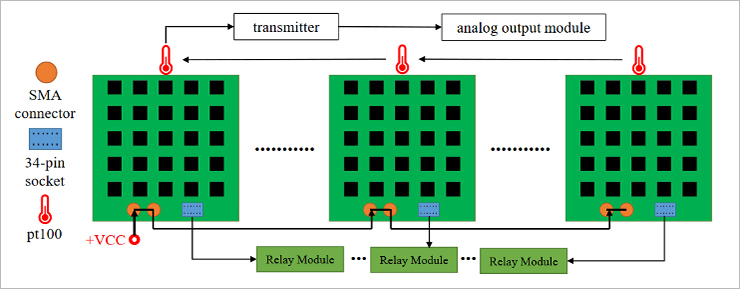Burn-in test and thermal performance evaluation of silicon photomultipliers in TAO Experiment
News, 10 September 2024
Employees of the Methodical Research Sector of the Laboratory of Nuclear Problems at JINR Nikolay Anfimov and Arseny Rybnikov together with their Chinese colleagues conducted comprehensive tests of SiPM tiles for the JUNO-TAO Experiment. An article about the tests was published in the Journal of Instrumentation in July 2024.
This study evaluates more than 4,000 tiles made of Hamamatsu visual-sensitive silicon photomultipier (SiPM). Each tile has a size of 5 × 5 cm2 and is intended for the central detector of the Taishan Antineutrino Observatory (TAO), a satellite experiment of the Jiangmen Underground Neutrino Observatory (JUNO), aimed at measuring the antineutrino energy of the reactor with unprecedented energy resolution.
 Experimental setup for the burn-in test featuring printed circuit boards within a temperature-monitored dark chamber
Experimental setup for the burn-in test featuring printed circuit boards within a temperature-monitored dark chamber
Each SiPM tile underwent a burn-in test at room temperature in the dark for two weeks, while cryogenic tests were used to analyse the temperature dependence of the parameters for SiPM samples only. Results from these comprehensive tests provide crucial data on the long-term performance and stability of the 10 square metres of SiPMs operating at -50°C to detect scintillation photons in the TAO Detector.
Despite some anomalies awaiting further examination, all SiPMs successfully withstood over two weeks of room temperature, which is equivalent to 6.7 years at -50°C. The results are also used to guide optimal SiPM selection, configuration, and operation, ensuring reliability and sustainability in reactor neutrino measurements. This work also provides insights for a rapid and stable quality assessment in future experiments that employ large-scale SiPMs as detection systems.
A burn-in test is a procedure in which components are exposed to extreme temperatures and/or voltages without input signals. This is a simple and inexpensive method for detecting failures in the early stages of device operation and conducting accelerated lifetime testing.
The TAO Antineutrino Observatory is part of the JUNO (Jiangmen Underground Neutrino Observatory) International Project, which aims to study the properties of neutrinos and antineutrinos. The specialised cryogenic detector of TAO is designed to work in conjunction with JUNO’s main detector to measure the energy spectrum of antineutrinos from the reactor with record accuracy. The smaller size of the TAO Detector is compensated by its improved technical characteristics and optimised design allowing for high measurement accuracy.